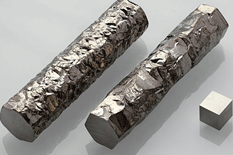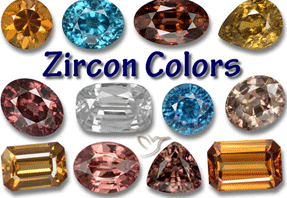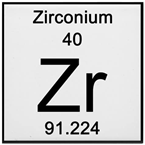Naming and History
The name of zirconium is derived from the Persian or Arabic word “Zargun” which means “gold or gold-colored”.
Zirconium is known from ancient times. It was used in precious stones such as hyacinth and zircon.
- Martin Heinrich Klaproth
Zirconium was first identified as an element by Martin Heinrich Klaproth in 1789, in Berlin, in a sample of zircon (zirconium silicate) from Sri Lanka. His evaluation of the mineral’s structure showed: 25% silica; 0.5% iron oxide; 70% new unidentified oxide. He called the new oxide ‘Zirconerde.’
- Sir Humphry Davy
In 1808, in London, Sir Humphry Davy attempted to obtain the pure metal from its oxide by electrolysis. However, he was not successful.
- Jacob Berzelius
Jacob Berzelius was the one who finally separated the metal in 1824, in Stockholm, Sweden. Berzelius heated an iron tube having a blend of potassium as well as potassium zirconium fluoride (K2ZrF6). He produced zirconium as an amorphous black powder.
- Anton Eduard and Hendrik de Boer
Dutch scientists Anton Eduard van Arkell and Jan Hendrik de Boer discovered an approach for producing high-purity zirconium in 1925. Zirconium tetraiodide (ZrI4) is decomposed on a white-hot tungsten filament producing a crystal bar of pure zirconium. This is called the crystal bar process.
Occurrence of Zirconium

Zirconium does not exist in its free elemental state. It is more abundant than copper and zinc. It is ten times in abundant than lead. The major ores containing zirconium are zircon, Kosnarite, Baddeleyite, Eudialyte, etc.
The main suppliers of Zirconium to the world are Australia, Sri Lanka, Brazil, and South Africa.
Properties of Zirconium
Zirconium is a silverish-grey, malleable, ductile, lustrous, and strong transition metal. It has a striking resemblance to titanium. It is very resistant to corrosion and heat. Zirconium is lighter than steel and harder than copper.
It does not dissolve in acids except hydrogen fluoride. Powdered zirconium spontaneously ignites in the air and is considered to be very dangerous. When zirconium is exposed to air, it forms a protective coating of oxide to prevent corrosion.
The melting point of zirconium is 1855°C and its boiling point is 4409°C. it exists as solid at room temperature. It has a density of 6.52 grams per cubic centimeter.
Zirconium in Biological Systems
Zirconium has no known significant role in living organisms. It has very low toxicity. This is not regarded as carcinogenic. But long-term exposure to zirconium powder can cause skin irritation in some people.
Uses of Zirconium
- It has the unique property that it does not absorb neutrons. That’s why it is used in nuclear power stations. 90% of zirconium is used in nuclear reactors.
- Zirconium is widely used in catalytic converters or catalysts such as in amination, hydrogenation, percussion caps or furnace bricks.
- It is used to remove traces of oxygen and other residual gases from vacuum tubes.
- Zirconium carbonate is used to treat poison ivy.
- It is alloyed with steel as a hardening agent and used in the manufacturing of some surgical equipment.
- Zircon – a transparent gemstone is used in jewelry.

- It is used in super magnets.
- Lithium zirconate is used to absorb carbon dioxide.
- It is used in heat exchangers, pipe fittings, etc.
- Zirconium is also used in photographic films and glass of television.
Isotopes of Zirconium
There are 5 isotopes of zirconium. The most abundant isotope of zirconium is Zr- 90 which has 51% of abundance.
MCQs about Zirconium
- What is the atomic number of zirconium?
- A) 39
- B) 40
- C) 41
- D) 42
- Answer: B) 40
- What is the atomic weight of zirconium?
- A) 91.2
- B) 92.2
- C) 93.2
- D) 94.2
- Answer: A) 91.2
- Who identified zirconium as an element in 1789?
- A) Sir Humphry Davy
- B) Martin Heinrich Klaproth
- C) Jacob Berzelius
- D) Anton Eduard van Arkell
- Answer: B) Martin Heinrich Klaproth
- What is the primary ore containing zirconium?
- A) Lead
- B) Zircon
- C) Copper
- D) Zinc
- Answer: B) Zircon
- Which process is used to produce high-purity zirconium?
- A) Electrolysis
- B) Crystal bar process
- C) Reduction with hydrogen
- D) Thermal decomposition
- Answer: B) Crystal bar process
- What is the melting point of zirconium?
- A) 1855°C
- B) 273°C
- C) 4409°C
- D) 0°C
- Answer: A) 1855°C
- Which property makes zirconium suitable for use in nuclear reactors?
- A) High toxicity
- B) Absorption of neutrons
- C) Low density
- D) High solubility in acids
- Answer: B) Absorption of neutrons
- What is the most abundant isotope of zirconium?
- A) Zr-90
- B) Zr-91
- C) Zr-92
- D) Zr-93
- Answer: A) Zr-90
- In which industry is zirconium widely used due to its resistance to corrosion and heat?
- A) Pharmaceutical
- B) Automotive
- C) Nuclear
- D) Textile
- Answer: C) Nuclear
- Which of the following is NOT a use of zirconium?
- A) Jewelry
- B) Removal of residual gases from vacuum tubes
- C) Treatment of poison ivy
- D) Catalyst in amination
- Answer: D) Catalyst in amination
- What is the symbol for zirconium?
- A) Zr
- B) Zn
- C) Zc
- D) Zm
- Answer: A) Zr
- Who discovered the method for producing high-purity zirconium in 1925?
- A) Martin Heinrich Klaproth
- B) Sir Humphry Davy
- C) Jacob Berzelius
- D) Anton Eduard van Arkell and Jan Hendrik de Boer
- Answer: D) Anton Eduard van Arkell and Jan Hendrik de Boer
- What is the primary color of zirconium powder when exposed to air?
- A) Black
- B) Yellow
- C) Blue
- D) White
- Answer: A) Black
- Which mineral containing zirconium is used in jewelry?
- A) Kosnarite
- B) Baddeleyite
- C) Eudialyte
- D) Zircon
- Answer: D) Zircon
- What is the density of zirconium?
- A) 4.47 grams per cubic centimeter
- B) 6.52 grams per cubic centimeter
- C) 7.87 grams per cubic centimeter
- D) 22.414 grams per cubic centimeter
- Answer: B) 6.52 grams per cubic centimeter
- Which scientist separated zirconium as an amorphous black powder in 1824?
- A) Martin Heinrich Klaproth
- B) Sir Humphry Davy
- C) Jacob Berzelius
- D) Anton Eduard van Arkell and Jan Hendrik de Boer
- Answer: C) Jacob Berzelius
- What is the boiling point of zirconium?
- A) 1855°C
- B) 273°C
- C) 4409°C
- D) 0°C
- Answer: C) 4409°C
- Which country is one of the main suppliers of zirconium to the world?
- A) India
- B) Russia
- C) Australia
- D) China
- Answer: C) Australia
- What is the origin of the name “zirconium”?
- A) Latin
- B) Greek
- C) Persian or Arabic
- D) German
- Answer: C) Persian or Arabic
- Which zirconium compound is used to absorb carbon dioxide?
- A) Zirconium carbonate
- B) Zirconium fluoride
- C) Zirconium chloride
- D) Zirconium oxide
- Answer: A) Zirconium carbonate
Summary: Zirconium Element Overview
Zirconium, classified as a transition metal in group 4 of the periodic table, possesses an atomic number of 40 and an atomic weight of 91.2, represented by the symbol “Zr.” Its appellation is rooted in the Persian or Arabic term “Zargun,” signifying “gold or gold-colored.”
Historical Context
Discovered in ancient times, zirconium found its modern identification through the work of Martin Heinrich Klaproth in 1789. Subsequent contributions from scientists like Sir Humphry Davy and Jacob Berzelius culminated in the successful isolation of zirconium, with advancements like the crystal bar process by Dutch scientists Anton Eduard van Arkell and Jan Hendrik de Boer in 1925.
Occurrence and Properties
Zirconium doesn’t occur in its elemental form but is abundant in various ores, including zircon and Kosnarite. Physically, zirconium exhibits silverish-grey characteristics, with notable resistance to corrosion and heat. Its propensity to ignite in powdered form and form an oxide coating upon exposure to air are key properties.
Biological and Industrial Applications
While zirconium lacks significant biological roles, its applications in various industries are vast. From its use in nuclear reactors and catalytic converters to its role in treating poison ivy and manufacturing surgical equipment, zirconium serves diverse purposes.
Isotopes
Zirconium is characterized by five isotopes, with Zr-90 being the most abundant, accounting for 51% of the total.
Overall, zirconium’s rich history, diverse applications, and unique properties make it a significant element in various industrial, scientific, and medical endeavors.

